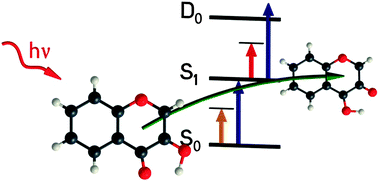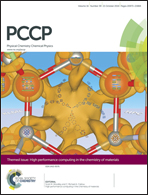A combined IR/IR and IR/UV spectroscopy study on the proton transfer coordinate of isolated 3-hydroxychromone in the electronic ground and excited state†
Abstract
In this paper the excited state proton transfer (ESPT) of isolated 3-hydroxychromone (3-HC), the prototype of the flavonols, is investigated for the first time by combined IR/UV spectroscopy in molecular beam experiments. The IR/UV investigations are performed both for the electronically excited and electronic ground state indicating a spectral overlap of transitions of the 3-HC monomer and clusters with water in the electronic ground state, whereas in the excited state only the IR frequencies of the proton-transferred monomer structure are observed. Due to the loss of isomer and species selectivity with respect to the UV excitations IR/IR techniques are applied in order to figure out the assignment of the vibrational transitions in the S0 state. In this context the quadruple resonance IR/UV/IR/UV technique (originally developed to distinguish different isomers in the electronically excited state) could be applied to identify the OH stretching vibration of the monomer in the electronic ground state. In agreement with calculations the OH stretching frequency differs significantly from the corresponding values of substituted hydroxychromones.


 Please wait while we load your content...
Please wait while we load your content...